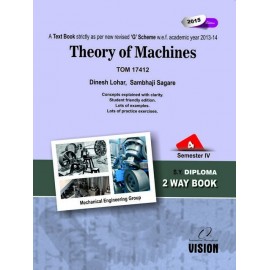Email: tovisionpune@gmail.com



Author: Dinesh Lohar, Sambhaji Sagare
Contents
1. Fundamentals and Type of Mechanisms
1. Introduction
1.1 Branches of Theory of Machines
1.2 Kinematic Link
1.3 Kinematic Pair and its Types
1.5 Kinematic Chain and Its Types
1.6 Mechanism
1.7 Inversion of a Mechanism
1.8 Machine and Mechanism
2. Inversions of Kinematic Chain
2.1 Inversions of Four Bar Chain or Quadric Cycle Chain
2.2 Inversion of Single Slider Crank Chain 24
2.3 Inversion of Double Slider Crank Chain 31
2. Velocity and Acceleration in Mechanism
1. Introduction
1.1 Important Basic Definitions
1.2 Concept of Relative Velocity of a Point on a Link
1.3 Methods to Find Out Velocity and Acceleration of Links in a Mechanism
2. Relative Velocity Method
3. Acceleration in Mechanism
3.1 Acceleration Diagram for a Link
3.2 Acceleration Diagram of Slider
3.3 Acceleration Diagram of Crank
4. Analytical Method for Determination of Velocity and Acceleration of Slider Crank Mechanism
5. Klein’s Construction for Slider Crank Mechanism
5.1 Klein’s Construction for Velocity Diagram of Slider Crank Mechanism
5.2 Klein’s Construction to Draw Acceleration Diagram of Slider Crank Mechanism
3. Cam and Followers
1. Introduction
1.1 Concept and Definition
1.2 Applications of Cams and Followers
2. Classification of Followers and Cams
2.1 Classification of Followers
2.2 Classification of Cams
3. Cam Terminology
4. Types of Motion of the Follower
4.1 Uniform Velocity or Uniform Motion
4.2 Simple Harmonic Motion (S.H.M.)
4.3 Uniform Acceleration and Retardation
4. Power Transmission
1. Introduction
1.1 Types of Drives
1.2 Comparison between Belt Drive and Chain Drive
2. Belt Drives
2.1 Selection of Belt Drive
2.2 Types of Belt
2.3 Materials for Belts
2.4 Types of Belt Drives
2.5 Angle of Contact or Angle of Lap
2.6 Length of Belt
2.7 Slip of Belt
2.8 Creep of Belt
2.9 Velocity Ratio
2.10 Power Transmitted by a Belt
2.11 Ratio of Driving Tensions for Flat Belt Drive
2.12 Tight Side and Slack Side of Belt21
2.13 Centrifugal Tension
2.14 Initial Tension in Belt
2.15 Conditions for Maximum Power Transmission by Belt Drive
2.16 Effect of Centrifugal Tension in a Belt Drive
3. Chain Drives
3.1 Advantages and Disadvantages of Chain Drive over Belt or Rope Drive
3.2 Selection of Chain and Sprocket Wheels
3.3 Method of Lubrication
4. Gear Drives
4.1 Gear Terminology
4.2 Advantages and Disadvantages as Compared to Belt or Rope and Chain Drives
4.3 Types of Gears
4.4 Gear Trains
4.5 Gear Lubrication
4.6 Law of Gearing
5. Flywheel and Governors
1. Flywheel
1.1 Applications of Flywheel with the help of Turning Moment Diagram
1.2 Turning Moment Diagram for a Four Stroke Cycle Internal Combustion Engine
1.3 Turning Moment Diagram for a Multicylinder Engine
1.4 Energy Stored in a Flywheel
1.5 Fluctuation of Energy
1.6 Fluctuation of Speed
2. Governor
2.1 Types of Governors
2.2 Terminology used in Governors
2.3 Construction and Working of Centrifugal Governors
2.4 Watt Governor
2.5 Porter Governor
2.6 Proell Governor
2.7 Spring Loaded Governors
2.8 Pickering Governor
3. Comparison between Flywheel and Governor
6. Brakes and Dynamometers
1. Introduction
2. Brakes
2.1 Definition of Brake
2.2 Functions of Brake
2.3 Factors of Capacity of Brake
2.4 Materials for Brake Lining
2.5 Characteristics of Brake Lining Materials
2.6 Types of Brakes
2.7 Single Block or Shoe Brake
2.8 Double Block or Shoe Brake
2.9 Band brake
2.10 Internal Expanding Brake
2.11 Disc Brake
3. Dynamometers
3.1 Types of Dynamometers
3.2 Difference between Brakes and Dynamometers
3.3 Absorption Dynamometer
3.4 Rope Brake Dynamometer
3.5 Hydraulic Dynamometer
3.6 Eddy Current Dynamometer
7. Clutches and Bearing
1. Clutches
1.1 Uniform Pressure Theory
1.2 Uniform Wear Theory
1.3 Functions of Clutch
1.4 Types of Clutches
2. Bearings
2.1 Types of Bearing
2.2 Equations for Torque and Power
8. Balancing
1. Introduction
1.1 Important Cases of Balancing of Rotating Masses
2. Analytical Method